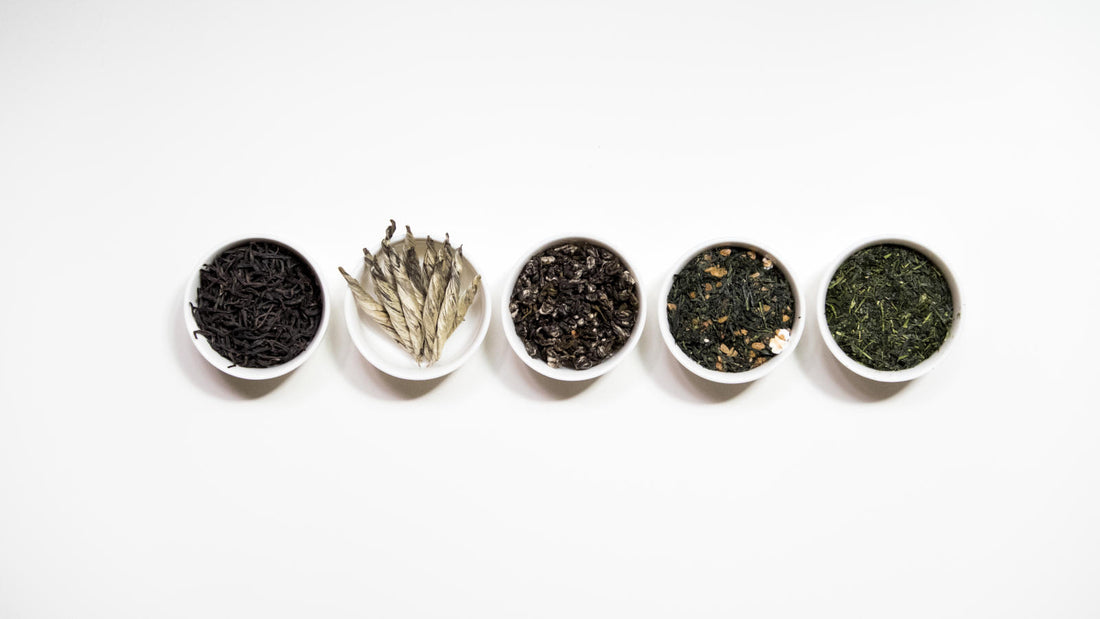In the Vol. 8 Exploration Kit, we are traveling to Japan and China to explore green teas! In the box, you'll find three green teas, one white tea and one black tea. While we tasted some Gyokuro in Vol. 5, it is not the most produced and consumed in Japan. Could you guess which tea that would be? Check out our tea stories below to learn more about what's in your cup.
Pillar White
Genmaicha
Jasmine Curl
Sencha
TGY Black
Here's a map to give you an idea of the journey this Exploration Kit will take you. Locations are approximate and intended to serve as a visual guide only.
Pillar White

手捲白茶
White Tea
Spring 2022
Simao, Yunnan, China
Yunnan, known as the birthplace of the tea tree with rich tea culture and cultivation practices, has always been at the forefront of producing high-quality teas. While Pu'er tea is their star tea genre, the Yunnan tea industry constantly strives for innovation. In our previous volumes, we introduced Moonlight White and BLC White. We proudly present another unique white tea from Yunnan: Pillar White.
Notes: Stone Fruit, Spice
Gongfu:
3.5g | 100ml | 85c | rinse/1.5 mins
Western:
3g | 250ml | 85c | 3-4 mins
Harvested and processed in Spring 2022, Pillar White stands out with its distinctive shape. This white tea is crafted from the Chang Ye Bai Hao cultivar, known for its densely covered trichomes. What sets this tea apart is its hand-rolled, pillar-shaped form. This shape not only protects the delicate trichomes but also allows for easy measurement and brewing, with each pillar weighing approximately 0.5g. We personally enjoyed its sweetness and the unique vegetal and spice note, that's distinctive in Yunnan raw Pu'er.
About Chang Ye Bai Hao
Chang Ye Bai Hao is the result of extensive research and experiments conducted by the Tea Research Institute of Yunnan Academy of Agricultural Sciences from 1973 to 1985. The institute focused on studying and breeding through Single Plant Selection in regions such as Xishuangbanna, Simao, and Lincang. With its signature trichomes, desirable infusion rate, and tea polyphenol content, Chang Ye Bai Hao was categorized as a provincial tea variety by the Yunnan Crop Variety Approval Committee in 1986.
Genmaicha

玄米茶
Green Tea
2022
Uji, Kyoto, Japan
Even if you have not heard of Genmaicha, you might have tasted it when you dine at a Japanese restaurant. Genmaicha or “brown rice tea” is a Japanese green tea consisting of green tea mixed with roasted brown rice. Occasionally, the rice pops during roasting, making them look like popcorn, so the tea has a nickname called “popcorn tea”.
Notes: Sweet, Toasty
Western:
5g | 150ml | 95c | 15-30 secs
Traditionally, Genmaicha is made with bancha, a low-grade green tea that is more affordable as it’s made from a later harvest than the higher-grade Sencha or Gyokuro. Nowadays, it’s common to find Genmaicha that is made with Sencha or has matcha added to the blend, in which case, it’s called Matcha-iri Genmaicha. Our Genmaicha is made with a Kabusecha mixed with roasted brown rice and mochi rice. Kabusecha is a Sencha that has been shaded for a short period of time. The tea leaves are darker in colour than non-shaded teas. It also brews up a sweeter-tasting tea with a beautiful jade green liquor.
History of Genmaicha
While there do not seem to be any definitive records of how Genmaicha came about, three interesting legends have talked about the creation of this tea. The first legend dated back to 15th century Japan, when a servant accidentally dropped grains of rice hidden up his sleeve into his master’s cup of tea.
Another story mentioned housewives who mixed brown rice into small amounts of green tea, which were too expensive for most commoners at the time, so everyone could enjoy it. And finally, the last and sound most probable is that Genmaicha came about in the 1900s when rice was added to make tea more available during times of hardship.
Regardless of how Genmaicha came about, we love its buttery and toasty flavours that goes well with sweet or savoury dishes!
Jasmine Curl

苿莉銀螺
Green Tea
Spring - Autumn 2022
Fuzhou, Fujian, China
Jasmine tea is undoubtedly one of the most universally appreciated teas, transcending nationalities and ethnicities. Its enchanting aroma has captivated the senses of countless tea enthusiasts. Nevertheless, it is crucial to understand that not all jasmine teas are created equal.
Notes: Floral, Grassy
Gongfu:
4g | 100ml | 80c | 30 secs
Western:
3g | 250ml | 80c | 1.5 mins
Fuzhou Jasmine tea stands out with its unique characteristic of not containing any flower petals. This distinction arises from the belief held by Fuzhou tea masters that withered flowers could impart an unpleasant taste to the tea. Instead, they take pride in keeping the unique traditional scenting technique (窨製): freshly picked jasmine flower buds are blended with the tea overnight and swiftly removed the following morning. This particular Jasmine tea is harvested and produced in spring 2022, and patiently awaited the jasmine season in autumn for the scenting procedure. This meticulous process has been repeated six times for this tea, resulting in a tea that boasts a full aromatic sensation without an artificially forced mouthfeel.
About Fuzhou Jasmine Tea
Jasmine was believed to have been introduced to China from Persia or Central Asia through the Silk Road during the Han Dynasty. Once in China, jasmine gained popularity, and its cultivation and appreciation became deeply ingrained in Chinese culture. Fuzhou has favorable conditions for growing high-quality jasmine flowers, which provided them with the perfect opportunity to develop and refine the art of jasmine tea scenting. The Fuzhou traditional jasmine tea scenting technique has achieved significant recognition and importance. In fact, it has been officially declared as one of China's Intangible Cultural Heritage by the government. This recognition signifies the importance of Fuzhou's jasmine tea scenting technique in creating a refined and aromatic tea that embodies the essence of jasmine.
Sencha


煎茶
Green Tea
Spring 2022
Yame, Fukuoka, Japan
In Vol. 6, we tried a Gyokuro from Yame, Fukuoka Prefecture. We’re delighted to have another Japanese tea, this time a single-cultivar Sencha from the same region.
Notes: Vegetal, Umami
Western:
3g | 150ml | 75c | 2 mins 10 secs
This Sencha is made from a single cultivar called Saemidori (さえみどり) which translates to “clear green” as the tea liquor takes on this colour. Saemidori is a relatively new cultivar and was bred by the Makurazaki Tea Research Station. As a cross between two cultivars, the Asatsuyu and Yabukita, Saemidori produces sweet, fragrant tea with little astringency while being better able to withstand frost, thus providing a higher yield.
History of Sencha
Sencha is one of the most consumed teas in Japan today but it hasn’t been around for very long.
In the 17th century, a Chinese Buddhist monk from Fujian named Ingen Ryūki moved to Japan just before the Edo period. He introduced an alternative way of drinking tea to the Japanese: steeping tea leaves in water and pouring the liquor into cups, as this was in fashion during the Ming Dynasty. This method of making tea came to be known as " simmered tea" or sencha (煎茶). During this period, loose leaf teas were either produced with teas grown outside of Uji, made from older leaves, or picked outside of the Spring season, as the young shoots and leaves are reserved for making matcha.
However, one tea farmer wanted to change that. Nagatani Souen, a tea farmer from the Uji area, spent 15 years experimenting with ways to improve the taste of loose leave teas. He developed the production method, named sencha, in 1738. Unique to this processing method is the rolling technique that kneads the tea leaves as they dry over a heated surface. This helps break down the cell walls to release more flavour at the time of brewing and give the tea its signature needle-shaped appearance.
TGY Black

觀音紅茶
Black Tea
Spring 2022
Anxi, Fujian, China
Tie Guan Yin, widely renowned as Iron Goddess of Mercy in the West, is a beloved oolong tea cherished by tea enthusiasts worldwide for its unique aroma, sweetness, and lingering mouthfeel. But have you ever wondered what would happen if this exceptional tea were processed into a black tea? Our tea producer pondered the same question, leading to the creation of TGY Black.
Notes: Sweet, Grain
Gongfu:
5g | 100ml | 90c | 15 secs
Western:
4g | 250ml | 90c | 2-3 mins
Harvested and processed in spring 2022 by our Tie Guan Yin tea farmer/producer in Anxi, this TGY Black pushes the boundaries of traditional tea processing techniques. While steadfast in preserving the Hong Xing cultivar (紅心歪尾桃), the producer sought to explore the potential of this varietal by incorporating tea processing methods from other regions, while considering the specific requirements of his own tea.
The result is TGY Black, featuring a profile reminiscent of Wuyi Xiao Zhong black tea but with a unique tone exclusive to this tea. The techniques and careful consideration of the varietal's characteristics have resulted in a truly remarkable and distinctive tea experience.
About Tea Types
During our tea events, we often emphasize that all six tea types originate from the same tea plant, Camellia Sinensis, as there is a common misconception that different tea types are derived from different plants. It’s true that certain varietals are more suitable for specific tea types based on their inherent features, advancements in tea processing techniques and knowledge sharing have encouraged tea producers to experiment with different approaches. As a result, we can anticipate the emergence of more innovative teas, such as TGY Black, in the market.

